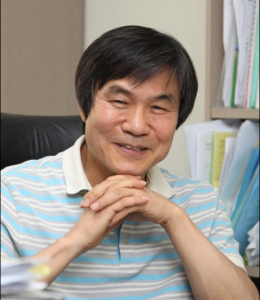- Speaker
- Prof. Jisoon Ihm
- Department of Physics and Astronomy, Seoul National University, Korea
- Abstract
Computational Physics is a powerful tool to analyze the mechanism of physical phenomena in solids and design novel materials for practical applications. We present our study on axion electrodynamics in topological insulators(TI) and materials design for hydrogen storage. In a 3-dimensional topological insulator (TI), metallic surface states of a single crystal can exist on all surfaces with different crystal orientations enclosing the crystal. First-principles electronic structure calculations as well as the analysis based on axion electrodynamics have been performed to study the mutual interactions between two adjacent surfaces of a TI. The difference in the work function between different crystal-face orientations generates a built-in electric field around facet edges and the magnetoelectric coupling in the TI may give rise to a line of effective magnetic dipoles. The predicted phenomenon exemplifies a manifestation of the axion electrodynamics in real solids. We, in collaboration with experimental groups, have been carrying out research and development to achieve high-capacity molecular hydrogen storage in porous materials at room temperature. Recently, we propose a strategy to store hydrogen in a potential well. We carry out electronic and atomic structure calculations on alkali-metal intercalated graphite oxide (GO) that can effectively provide a 2-dimensional potential well for hydrogen storage. It is found that the alkali-metal ion such as K+ induces dipole moment in hydrogen and it contributes to the binding of H2 to the system, in addition to the usual van der Waals (dispersion) interaction with GO. This mechanism allows for enormously enhanced H2 storage in agreement with experiment.
- About the Speaker
Prof. Ihm obtained PH. D. degrees in Physics from University of California at Berkeley in 1984 (supervisor: M. L. Cohen). He is now a distinguished professor in the School of Physics at Seoul National University, Korea. He is a Foreign Associate of National Academy of Sciences of USA, Fellow of American Physical Society, Academician of Korean Academy of Science and Technology Currently and Fellow of Korean Physical Society. He has been designated as a Korean Scientist of Highest Honor by President of Korea and National Scholar of Korea by the Ministry of Education of Korea. He was also awarded a National Decoration and the Korea Science Award in Physics, both by President of Korea. He has published around 200 papers in Nature, Science, PRL, etc. He is well-known for his breakthrough contributions in developing the momentum-space formalism for calculating the total energy of solids, which is one of the most important steps in developing first-principles total energy calculations.
- Date&Time
- 2016-05-24 3:00 PM
- Location
- Room: Conference Room I




